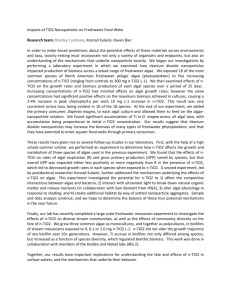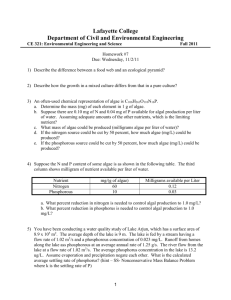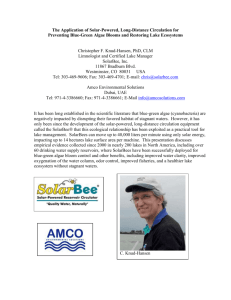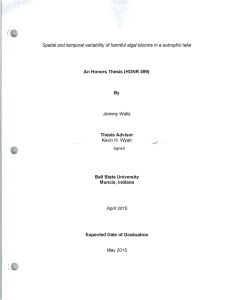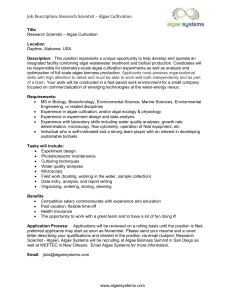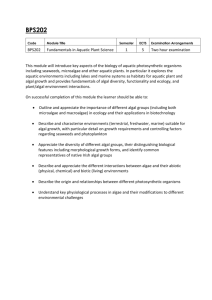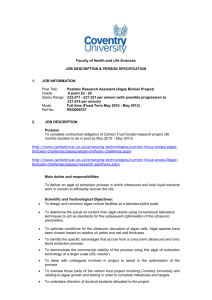A Computer Simulation of Algae Growth in the Planktonic Zone
advertisement
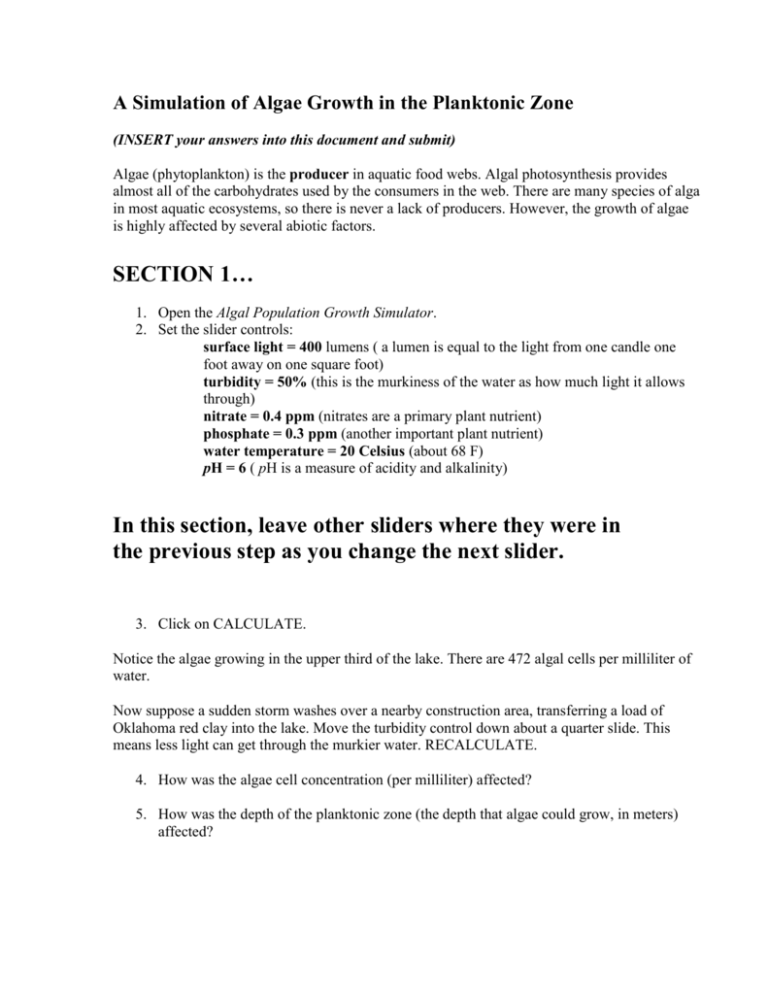
A Simulation of Algae Growth in the Planktonic Zone (INSERT your answers into this document and submit) Algae (phytoplankton) is the producer in aquatic food webs. Algal photosynthesis provides almost all of the carbohydrates used by the consumers in the web. There are many species of alga in most aquatic ecosystems, so there is never a lack of producers. However, the growth of algae is highly affected by several abiotic factors. SECTION 1… 1. Open the Algal Population Growth Simulator. 2. Set the slider controls: surface light = 400 lumens ( a lumen is equal to the light from one candle one foot away on one square foot) turbidity = 50% (this is the murkiness of the water as how much light it allows through) nitrate = 0.4 ppm (nitrates are a primary plant nutrient) phosphate = 0.3 ppm (another important plant nutrient) water temperature = 20 Celsius (about 68 F) pH = 6 ( pH is a measure of acidity and alkalinity) In this section, leave other sliders where they were in the previous step as you change the next slider. 3. Click on CALCULATE. Notice the algae growing in the upper third of the lake. There are 472 algal cells per milliliter of water. Now suppose a sudden storm washes over a nearby construction area, transferring a load of Oklahoma red clay into the lake. Move the turbidity control down about a quarter slide. This means less light can get through the murkier water. RECALCULATE. 4. How was the algae cell concentration (per milliliter) affected? 5. How was the depth of the planktonic zone (the depth that algae could grow, in meters) affected? Later during the same storm, runoff from a farm that had just received an application of manure fertilizer was washed into one of the lake’s tributary creeks. 6. Increase the nitrate level to 0.6 parts per million. What effects does this have on the planktonic zone depth and the cells concentration? The flood waters were so intense that they engulfed a nearby residential area. the septic systems from the houses contained a significant amount of phosphate detergents that are now introduced into the lake ecosystem. 7. Increase the phosphate level to 0.4 ppm. What is the effect? The heavy rains also brought cooler temperatures. 8. Decrease the water temperature to 18C. What is the effect? As you know, temperature is an important factor in biochemistry and all chemical reactions. In living organisms, do you think inceasing temperature will continually cause an increase in activity, growth, development, etc.? Take the thought to its extreme. If you raised the water temperature to boiling, what would be the effect on the algae? Obviously not good. therefore we can talk about an optimum temperature that is not too hot or too cold, but just right. 9. Find the optimum temperature for algal growth in this ecosystem by playing with the temperature control and watching the cell concentration. What is the optimum temperature? SECTION 2… Move all the sliders to the middle position. Keep them all here unless instructed to change. The amount of acid or alkali in water is measured by pH. The pH scale goes from 1 (strongly acid) to 14 (strongly alkaline, or base). pH is determined by such factors as the type of rock and soil present, amount of decaying matter in the water, acid precipitation, and certain types of pollution. 10. Find the optimum pH for algal growth: What is the optimum… 11. light level? 12. turbidity? 13. nitrate level? 14. phosphate level? 15. What set of parameters give the highest cell concentration? (Change all sliders as needed) 16. What set of parameters give the lowest cell concentration? (Change all sliders as needed) 17. Is it possible to have the same number of total algal cells in the lake yet have different planktonic zone depths? Explain:


